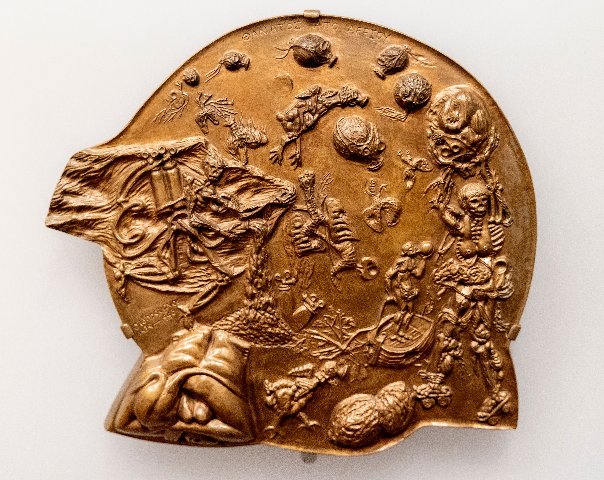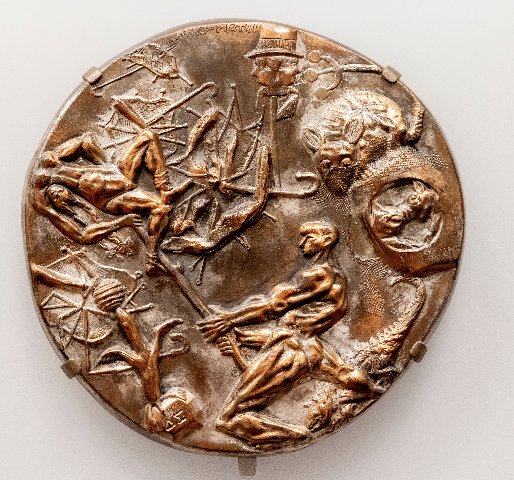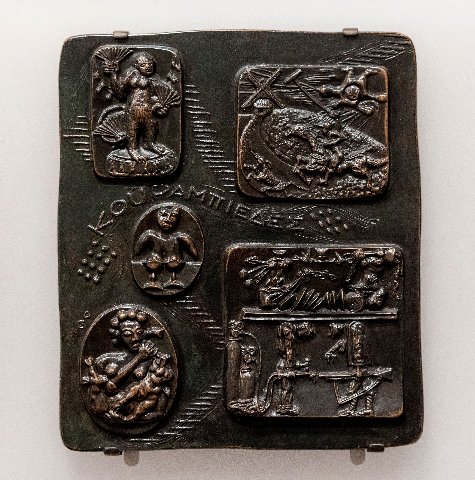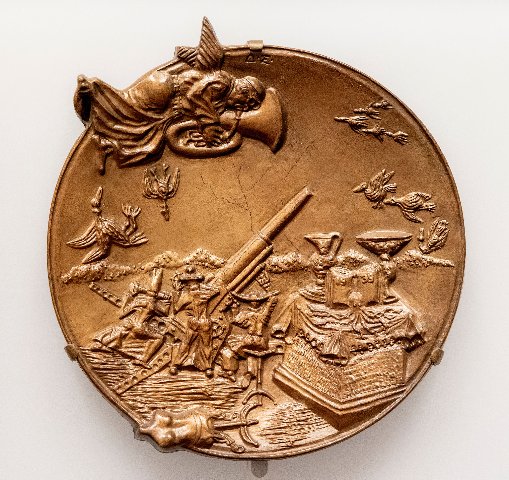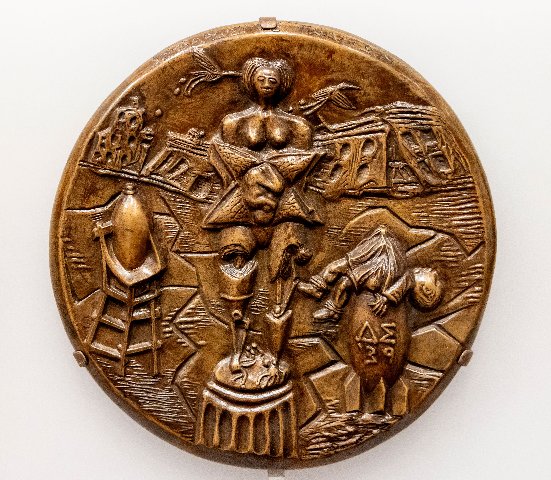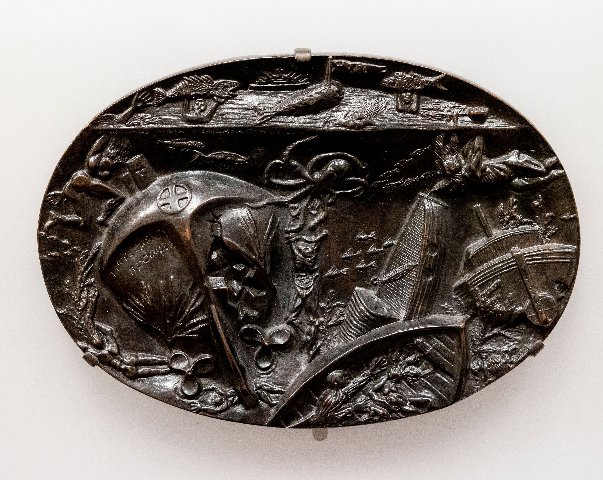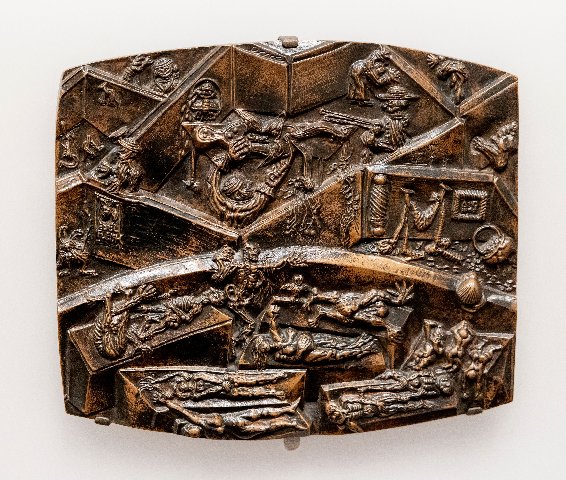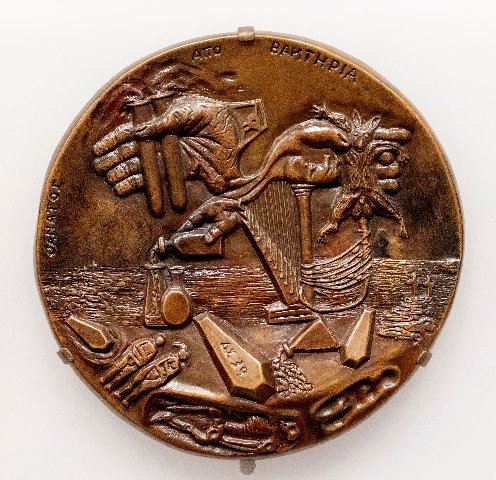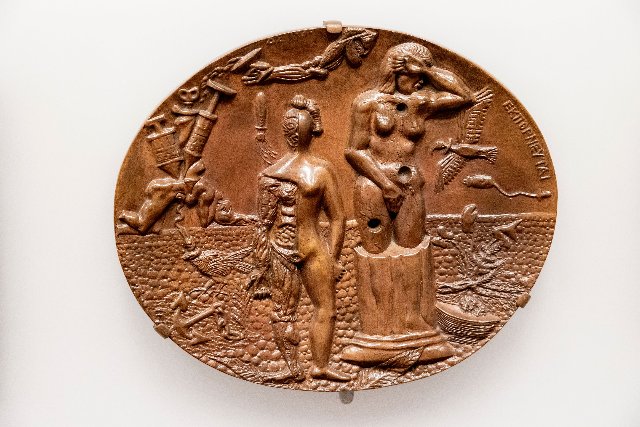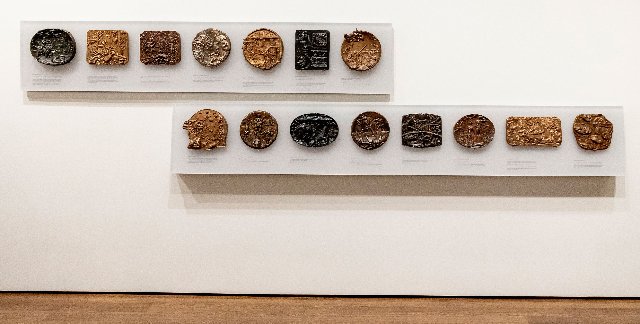David Smith's Medals of Dishonor
Ripped From the Headlines Relevance Today
By: Charles Giuliano - Dec 31, 2023
Roland David Smith (March 9, 1906 – May 23, 1965), born in Decatur, Indiana, was the marquee sculptor in the generation of abstract expressionists that straddled WW11. During the war he worked in a factory that produced locomotives and tanks. He evolved to use found and industrial materials to create large, welded, geometric constructions.
He was influenced by the steel sculptures of Julio Gonzalez and Pablo Picasso. Smith was the first American to work in this manner. Many of the Cubi sculptures, his best known series, were polychromed. When he died as the result of an automobile accident a number of unfinished works were located on the grounds of his Bolton Landing, New York home and studio.
The executor of the estate, art critic Clement Greenberg, ordered the removal of priming paint. The resultant highly polished stainless steel, not the artist’s attention, is how the sculptures are perceived today. There is an early Cubi owned by Harvard University, one of the largest collections of his work, that remains polychromed.
On the cusp of WWII, Smith who had socialist objections to fascism and war, created a series of fifteen, dinner-plate-scaled, bronze reliefs known as Medals for Dishonor. Fourteen of them have been donated from the estate to the Harvard Art Museums. The fifteenth is on extended loan.
Arguably, they are the most significant bronze reliefs since those of Ghiberti for the doors of the Baptistry in Florence.
“This transformative gift allows the museums to continue to exhibit, study, and teach with these critical early works in the way that the artist himself envisioned,” said Sarah Kianovsky, who recently retired as Curator of the Collection in the Division of Modern and Contemporary Art at the Harvard Art Museums.
There is irony that the roiling series is on view at Harvard. Controversy and campus unrest have resulted from the testimony of its president before Congress. Dr Claudine Gay, 53, was forced to apologize after she failed to say whether students calling for the genocide of Jewish people would be disciplined. Under mounting pressure, on January 2, 2024, she resigned
When Smith engaged with the horrors of war there were numerous predecessors in the Fine Arts. The 2nd of May 1808 by Francisco Goya his“The Fight of the Mamelukes” and The 3rd of May 1808 or “The Executions” were painted to document the atrocities of Napoleon’s invasion.
The first painting depicts citizens defending themselves against mercenaries. The second work represents the executions that went on day and night. The crime for which an endless row of citizens are being executed is that of defending themselves from invasion.
Goya’s related series of prints, Disasters of War, were printed posthumously. A soldier during WWI, the German artist, Otto Dix, created a similar series. His peers George Grosz and John Heartfield also made works condemning war and the Nazis.
Pablo Picasso’s “Guernica” was long displayed at the Museum of Modern Art. The artist willed that it would return to Spain when, post Franco, the nation would again be a democracy. The epic painting is a response to German bombing of the village of Guernica. When I got too close at Museo Nacional Centro de Arte Reina Sofía in Madrid, I was surprised when an alarm went off. “Innocent bystanders” suddenly whipped out weapons. The epic painting is under palpable threat of attacks by fascists.
The display of Smith’s bronze reliefs could not be more relevant and timely. While Picasso’s “Guernica” evokes outrage over a single event, there are almost daily Guernicas in Ukraine, Russia, and Gaza. The unprovoked, October 7 terrorist attack by Hamas, resulted in 1,139 deaths – 695 Israeli civilians, among them 36 children, as well as 373 members of security forces and 71 foreigners. Hamas took some 250 hostages.
World opinion condemned Hamas, particularly with reports of sexual assault and massacre of women and children. The pendulum has swung, however, as the IMF has killed more than 22,000 and mounting that combines combatants and citizens. With the intent to take out Hamas the counter attack has been less than precise and surgical. This includes bombing of camps, hospitals and neighborhoods.
Outrage on both sides have exploded on college campuses. Jewish and Islamic students state that they are not safe on campus. No doubt Harvard’s Smith works are an active element for exploring issues of war, atrocities, profiteering and systemic genocide.
From January 22, 1999 – March 7, 1999 the medals and 91 related works ranging in date from 1936 to 1943, including drawings, sketchbooks, paintings, collages, and several preliminary casts were shown at the Boston University Art Gallery. It was part of a five venue, traveling exhibition organized by Matthew Marks Gallery. John Stomberg, now director of Dartmouth’s Hood Museum, was then the BU Gallery curator. I recall vividly engaging him about the work which I reviewed.
At the time, I was teaching an avant-garde seminar for Metropolitan College of Boston University. My class met in the gallery to discuss the exhibition. It did not go well. Instead of absorbing Smith’s intent several of the students strongly reacted to the content, particularly the graphic collages and sketches related to the reliefs. I was put on the defensive for exposing them to the material. The imagery was indeed strong and violent but it conveyed the undeniable point that war is obscene.
There were similar responses when I took BU and Suffolk University classes to the ICA to view the Robert Mapplethorpe exhibition. The most explicit works, his XYZ series, were displayed behind a curtain and one volunteered to see them. Students had that option. I was invited to address the student body of Salem State College about the exhibition. I projected the work as well as examples of erotic art from classical Greek pots.
Artists, by their very nature, often explore and depict images that offend the general public. The Metropolitan Museum is currently exhibiting one such example Edouard Manet’s seminal nude “Olympia” (1863). As the late Robert Hughes put it, the iconic painting evoked “The Shock of the New” when initially displayed in the Paris salon.
Fortunately, I no longer have to deal with the systemic erosion of Academic Freedom. There was student blowback when I taught de Kooning’s “Women” or paintings by the surrealist Balthus. It was challenging to defend the significance of this work in the canon. Today, for offending a single student, no doubt I would be censured or even fired.
I fear for the future in now woke academies with censored textbooks and school libraries. Imagine teaching relevant humanities and art history in the Florida of Governor Ron De Santis? The arts, languages and humanities are being squeezed out of universities while more pragmatic science and technology has been expanded. This appears to be an irreversible trend.
College is where future generations are exposed to ideas and challenges that shape the future of America. Insisting on safe places and sanitized class rooms is a broad assault on critical thinking and free speech. One such horrific example is the attempt to expunge slavery from the teaching of American history. How is the genocide of Native Americans dealt with in the curriculum?
Smith’s subject matter is directed at political and corporate support for fascism in the United States, and each medal depicts a particular wartime evil. "Bombing Civilian Populations" refers to the devastation of the Spanish town of Guernica; "The Fourth Estate," to the establishment’s attack on artistic and intellectual freedoms; "Munitions Makers," to rampant war profiteering and the complicity of big business. Other medals refer to the Ku Klux Klan, anti-Semitism, and biological warfare.
The works are relatively small in scale and richly detailed. In “Munition Makers” frontal skeletons hold weapons while surrounded by tanks and artillery. A figure to the left has been splayed open revealing organs.
In"Propaganda for War" (1939–40) Smith stated "The rape of the mind by machines of death – the Hand of God points to atrocities. Atop the curly bull the red cross nurse blows the clarinet. The horse is dead in this bullfight arena – the bull is docile, can be ridden."
“Co-operation of Clergy” was inspired by the inflammatory, pro fascist, anti-Semitic rhetoric of radio’s influential Father Charles Coughlin. It is well documented that Pope Pius XII turned a blind eye to Hitler and genocide. In the relief an angel blowing a tuba hovers over battlefield artillery.
The tondo, “Bombing Civilian Populations,” has a dominant, standing, female figure with her uterus blown open to reveal a fetus. How many infants are currently being slaughtered including a nursery of abandoned premature babies in a bombed Gaza hospital?
While officers largely comprise the upper classes the ranks of enlisted men swell with the inner city poor. “War Exempt Sons of the Rich,” focuses on how the wealthy avoid the draft. During the Civil War one could pay to have a surrogate enlisted. Generally, the military industrial complex profits from war. They are the focus of “Munitions Makers.”
While shocking and relevant when first created, it is agonizing to state that Medals of Dishonor are no less so today. As we enter a new year, we will look back at 2023 as a time of war, atrocities and genocide. Unfortunately, there seems to be no end in sight.

